The Influence of a Photovoltaic Micro-Installation on the Low-Frequency Parameters of Electricity at PCC and Its Impact on the Thermal Characteristics of Selected Devices
Abstract
:1. Introduction
- Power flows from LV (Low Voltage) grid to MV (Medium Voltage) grid;
- The occurrence of an increase in voltage on the lines caused by the reverse operation of current loads;
- Problems with voltage control at network control points (power flows from different directions);
- Increase in losses on transmission systems related to power flows;
- Problems with reactive power flows and their distribution;
- Formation of unbalance in the reference to differences between phases L 1–L 2–L 3.
- Energy quality;
- Electromagnetic compatibility of devices cooperating with networks in which there are photovoltaic installations.
2. Tested Micro Installation
- Converter power 3.68 kW;
- Rated supply voltage 160–480 V (DC);
- Output voltage 230 V (AC);
- Rated input current 11 A;
- Maximum output current 16 A;
- Rated operating frequency 50/60 Hz;
- The photovoltaic installation was put into operation in April 2019.
3. Measurements
4. Evaluation of Selected Objects
- Measurements at undistorted voltage of U = 230 V;
- Harmonics of levels resulting from the measurements carried out at PCC (harmonics levels were applied in accordance with Table 5);
- Harmonics as in point (b) and the constant component UDC = 0.5 V;
- Harmonics as in point (b) and the constant component UDC = 18 V.
5. Test Results
6. Analysis of the Results
7. Conclusions
- DC suppression converters;
- DC compensation methods;
- Capacitor blocking method;
- Physical capacitors;
- Virtual capacitor;
- Intelligent control.
Author Contributions
Funding
Institutional Review Board Statement
Informed Consent Statement
Data Availability Statement
Acknowledgments
Conflicts of Interest
References
- Solar Energy. Available online: https://www.irena.org/solar (accessed on 18 March 2021).
- Installed Power (MW)—The National Potential of Renewable Energy Sources in Numbers-Urząd Regulacji Energetyki. Available online: https://www.ure.gov.pl/pl/oze/potencjal-krajowy-oze/5753,Moc-zainstalowana-MW.html (accessed on 9 April 2020).
- The National Potential of Renewable Energy Sources in Numbers-Urząd Regulacji Energetyki. Available online: https://www.ure.gov.pl/pl/oze/potencjal-krajowy-oze (accessed on 18 March 2021).
- Wirth, H.; Ise, F. Recent Facts about Photovoltaics in Germany, version of 11 March 2021; ISE: Freiburg, Germany; Available online: https://www.ise.fraunhofer.de/en/publications/studies/recent-factsabout-pv-in-germany.html (accessed on 9 April 2020).
- Solar PV Lights the Way to Energy Transition|Red Eléctrica de España. Available online: https://www.ree.es/en/press-office/news/featured-story/2020/04/solar-pv-lights-way-energy-transition (accessed on 18 March 2021).
- Installation ENERGA S.A Connection Code. Available online: https://www.energa-operator.pl/upload/wysiwyg/dokumenty_do_pobrania/uslugi/przylaczenie_do_sieci/kodeksy_sieciowe/Procedura_uzytkowanie_modulu_wytwarzania_typA_Zgloszenie.pdf (accessed on 18 March 2021).
- Quiroga, G.A.; Kagan, H.; Amasifen, J.C.C.; Almeida, C.F.M.; Kagan, N.; Vicentini, E. Study of the Distributed Generation impact on distributed networks, focused on quality of power. In Proceedings of the 2016 17th International Conference on Harmonics and Quality of Power (ICHQP), Belo Horizonte, Brazil, 16–19 October 2016; pp. 855–860. [Google Scholar] [CrossRef]
- Wang, Y.; Kuckelkorn, J.; Liu, Y. A state of art review on methodologies for control strategies in low energy buildings in the period from 2006 to 2016. Energy Build. 2017, 147, 27–40. [Google Scholar] [CrossRef]
- Zhang, J.; Ma, Q.; Xia, S.; Huan, G. Research on the Power Quality Control of Distributed Photovoltaic Power. In Proceedings of the 2019 IEEE International Conference on Energy Internet (ICEI), Nanjing, China, 20–24 May 2019; pp. 461–465. [Google Scholar] [CrossRef]
- Ibrahem, H.; Yehia, D.M.; Azmy, A.M. Power Quality Investigation of Distribution Networks with High Penetration of Solar Energy. In Proceedings of the 2019 21st International Middle East Power Systems Conference (MEPCON), Cairo, Egypt, 17–19 December 2019; pp. 1193–1198. [Google Scholar] [CrossRef]
- Do, D.-T.; Hirsch, H. EMI Filter Performance of Transformerless Topology for Photovoltaic Applications. In Proceedings of the 2020 International Symposium on Electromagnetic Compatibility-EMC EUROPE, Glasgow, UK, 30 July–6 August 2021; pp. 1–6. [Google Scholar] [CrossRef]
- Ping, H.; Dong, L.; Xin, Q. Influence of Grid-connected Photovoltaic Systems on Power Quality. In Proceedings of the 2019 IEEE 2nd International Conference on Automation, Electronics and Electrical Engineering (AUTEEE), Shenyang, China, 22–24 November 2019; pp. 447–451. [Google Scholar] [CrossRef]
- Lumbreras, D.; Gálvez, E.; Collado, A.; Zaragoza, J. Trends in Power Quality, Harmonic Mitigation and Standards for Light and Heavy Industries: A Review. Energies 2020, 13, 5792. [Google Scholar] [CrossRef]
- Anzalchi, A.; Sundararajan, A.; Moghadasi, A.; Sarwat, A. Power quality and voltage profile analyses of high penetration grid-tied photovoltaics: A case study. In Proceedings of the 2017 IEEE Industry Applications Society Annual Meeting, Cincinnati, OH, USA, 1–5 October 2017; pp. 1–8. [Google Scholar] [CrossRef]
- Mazzanti, G.; Passarelli, G.; Russo, A.; Verde, P. The effects of voltage waveform factors on cable life estimation using measured distorted voltages. In Proceedings of the 2006 IEEE Power Engineering Society General Meeting, PES, Montreal, QC, Canada, 18–22 June 2006. IEEE Computer Society. [Google Scholar] [CrossRef]
- Mazzanti, G. Reliability evaluation of insulation subjected to harmonic voltages within the limits set by international standards. IEEE Trans. Dielectr. Electr. Insul. 2014, 21, 2037–2046. [Google Scholar] [CrossRef]
- EU Grid Code EUR-Lex-32016R0631-EN-EUR-Lex. Available online: https://eur-lex.europa.eu/legal-content/EN/ALL/?uri=OJ:JOL_2016_112_R_0001 (accessed on 18 March 2021).
- Olowu, T.O.; Sundararajan, A.; Moghaddami, M.; Sarwat, A.I. Future challenges and mitigation methods for high photovoltaic penetration: A survey. Energies 2018, 11, 1782. [Google Scholar] [CrossRef] [Green Version]
- Doron, P.; Karni, J.; Slocum, A. A generalized approach for selecting solar energy system configurations for a wide range of applications. MRS Energy Sustain. 2019, 6, e11. [Google Scholar] [CrossRef] [Green Version]
- Al-Shetwi, A.Q.; Hannan, M.A.; Jern, K.P.; Alkahtani, A.A.; PG Abas, A.E. Power Quality Assessment of Grid-Connected PV System in Compliance with the Recent Integration Requirements. Electronics 2020, 9, 366. [Google Scholar] [CrossRef] [Green Version]
- Kroposki, B.; Johnson, B.; Zhang, Y.; Gevorgian, V.; Denholm, P.; Hodge, B.-M.; Hannegan, B. Operating Electric Power Systems with Extremely High Levels of Variable Renewable Energy. IEEE Power Energy Mag. 2017, 15, 61–73. [Google Scholar] [CrossRef]
- Soonwook Hong, P.; Michael Zuercher-Martinson, P.D. White Paper Harmonics and Noise in Photovoltaic (PV) Inverter and the Mitigation Strategies; Solectria Renewables: Lawrence, MA, USA, 2020; Available online: https://www.solectria.com/site/assets/files/1482/solectria_harmonics_noise_pv_inverters_white_paper.pdf (accessed on 18 March 2021).
- Dartawan, K.; Hui, L.; Suehiro, M. Harmonics Issues That Limit Solar Photovoltaic Generation On Distribution Circuits; Pterra LLC: New York, NY, USA, 2012; Available online: https://www.pterra.com/wp-content/uploads/2013/10/Solar_Paper_0482_Harmonics.pdf (accessed on 18 March 2021).
- Long, B.; Zhang, M.; Liao, Y.; Huang, L.; Chong, K. An Overview of DC Component Generation, Detection and Suppression for Grid-Connectedn Converter Systems. IEEE Access 2019, 7, 110426–110438. [Google Scholar] [CrossRef]


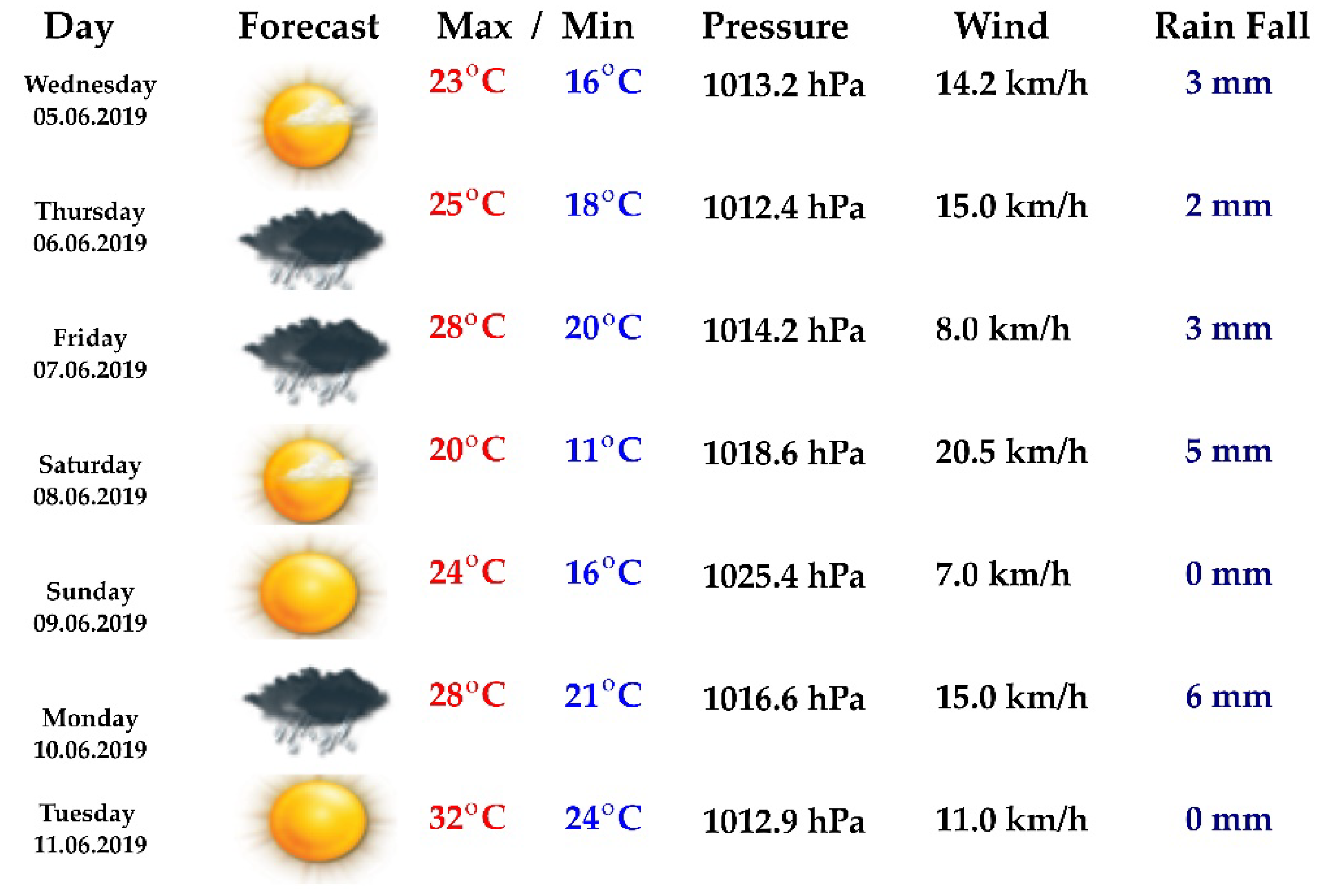


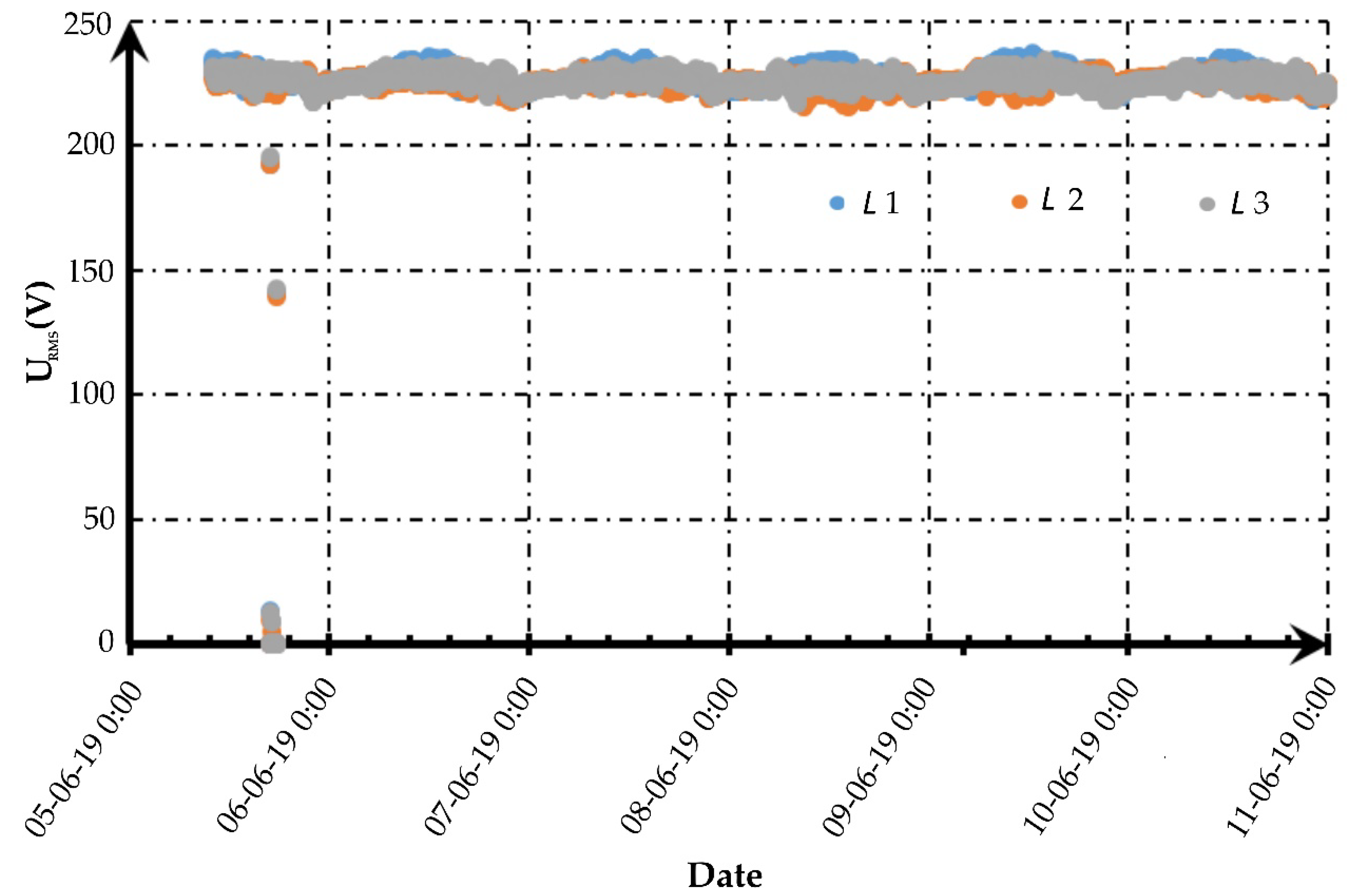
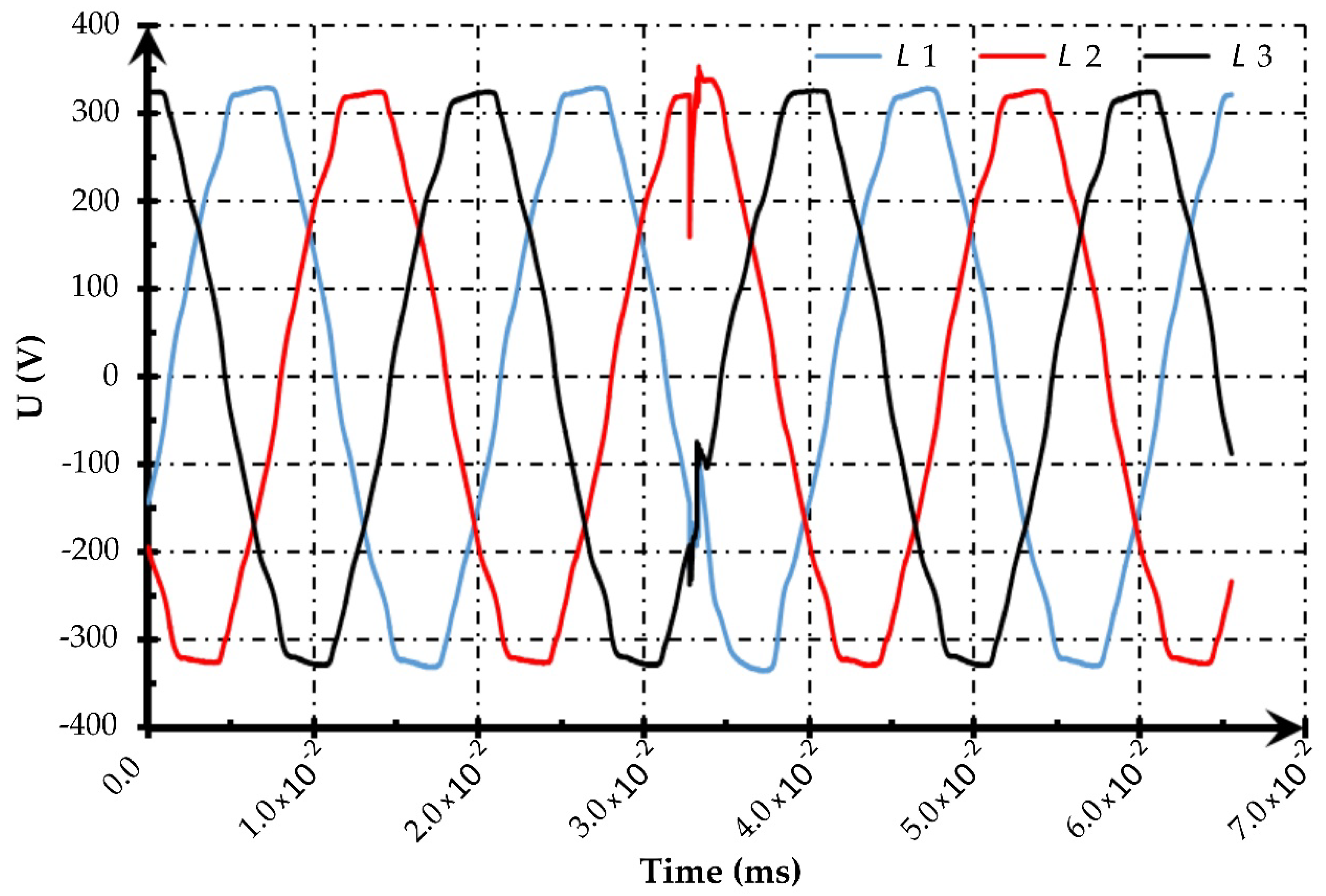

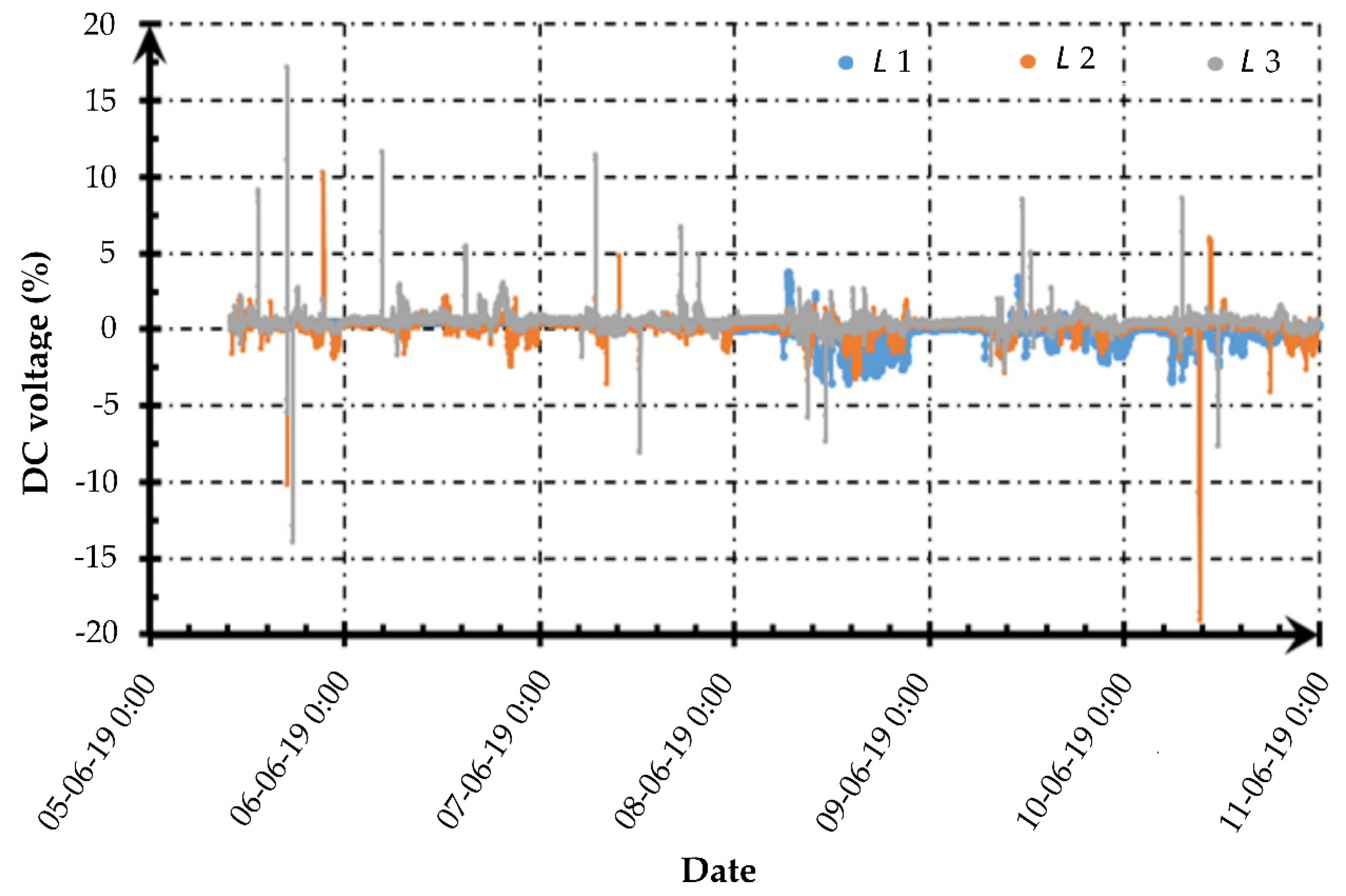
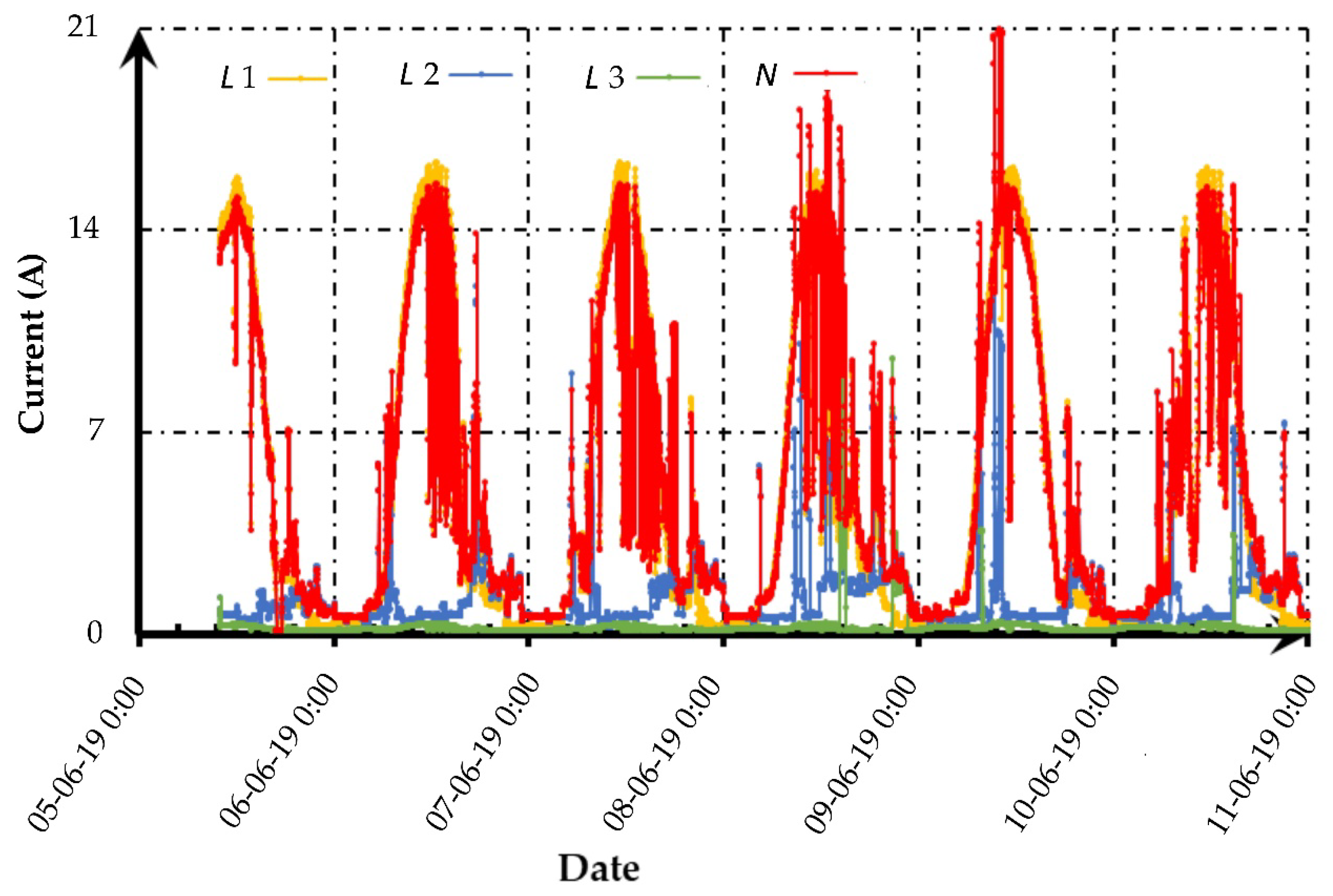
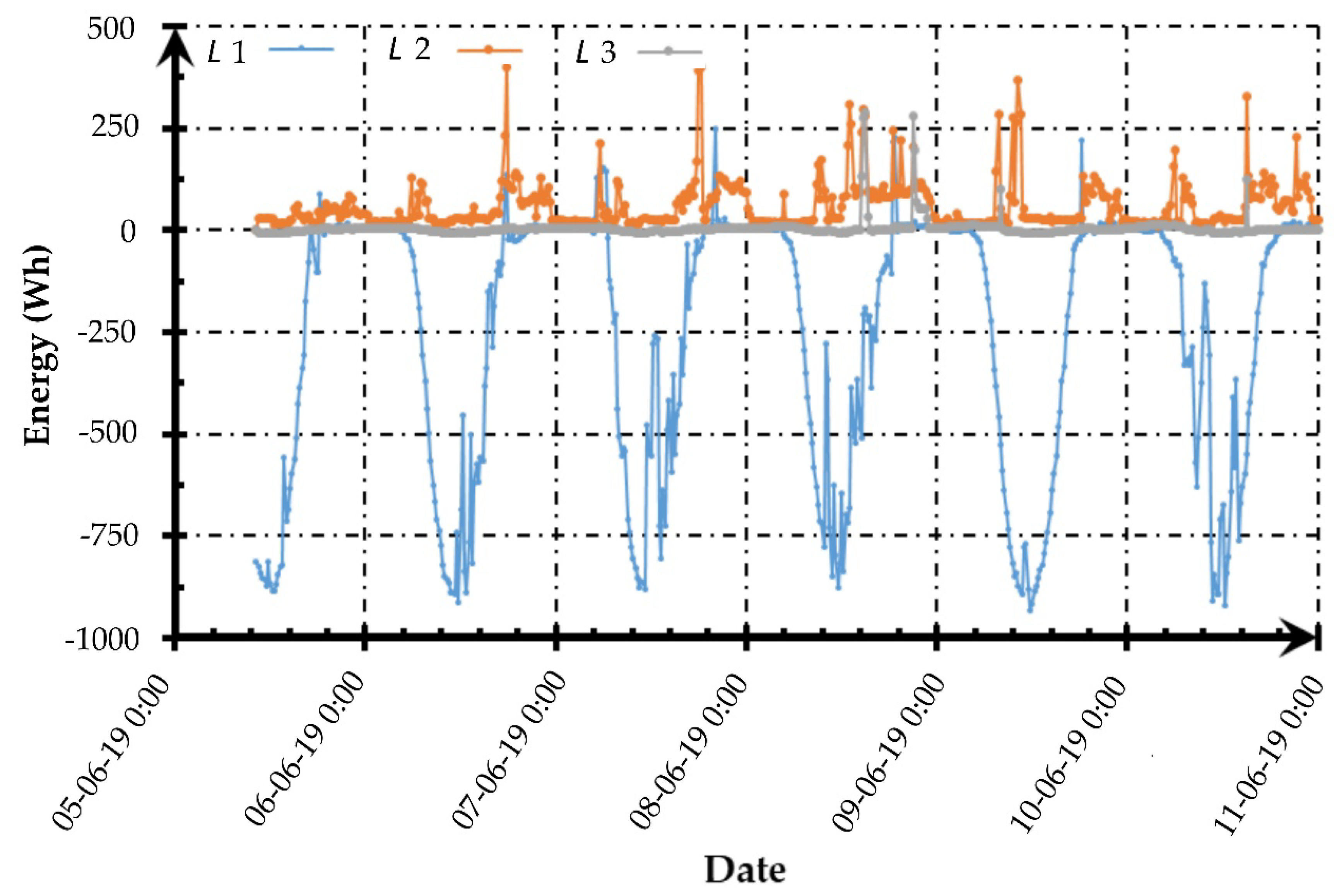

| Parameter | Unit | Max | 95% | Min |
|---|---|---|---|---|
| Frequency | Hz | 88.61 | 50.05 | 49.89 |
| Voltage L 1 | V | 237.02 | 233.26 | 218.16 |
| Voltage L 2 | V | 233.12 | 229.25 | 214.33 |
| Voltage L 3 | V | 234.23 | 230.26 | 217.21 |
| THD L 1 | % | 8.37 | ||
| THD L 2 | % | 18.64 | ||
| THD L 3 | % | 9.23 | ||
| Voltage Unbalance | (events) | 40 |
| Voltage Unbalanced | ||||||||
| Events | 10 ≤ t < 200 | 200 ≤ t < 500 | 500 ≤ t < 1000 | 1000 ≤ t < 5000 | 5000 ≤ t < 60,000 | |||
| (%) | (ms) | |||||||
| 90 > U ≥ 80 | 1 | 0 | 0 | 0 | 0 | |||
| 80 > U ≥ 70 | 2 | 1 | 0 | 0 | 0 | |||
| 70 > U ≥ 40 | 1 | 1 | 0 | 0 | 0 | |||
| 40 > U ≥ 5 | 0 | 0 | 0 | 0 | 0 | |||
| U< 5 | 0 | 0 | 12 | 6 | 16 | |||
| Voltage increase | ||||||||
| (%) | 10 ≤ t < 500 | 500 ≤ t < 5000 | 5000 ≤ t < 60,000 | |||||
| U ≥ 120 | 0 | 0 | 0 | |||||
| 120 > U ≥ 110 | 0 | 0 | 0 | |||||
| Item | Symbol | Declared Parameters |
|---|---|---|
| Power suppy | A 1 | Un = 230 V; 60 VA; 50 Hz; Uout = 18 V; Iout = 3 A; |
| LED lighting source | O 1 | Un = 230 V; 50 Hz, 80 mA, 11 W, 2700 K, 1055 lm; |
| Fluorescent lighting source | O 2 | Un = 220–230 V; 50 Hz; 17 W; |
| Power transformer | TR 1 | Un = 230 V; 35 VA; 47–63 Hz, Uout = 18 V; Iout = 2 A; |
| Power transformer | TR 2 | Un = 230 V; 20 VA; 50 Hz; Uout = 18 V Iout = 1 A |
| Test | Voltage | Harmonics | UDC |
|---|---|---|---|
| - | V | - | V |
| T 1 | 230 | - | 0.0 |
| T 2 | 230 | As per Table 5 | 0.0 |
| T 3 | 230 | As per Table 5 | 0.5 |
| T 4 | 230 | As per Table 5 | 18.0 |
| Harmonics | Value | Angle | Harmonics | Value | Angle |
|---|---|---|---|---|---|
| - | % | ° | - | % | ° |
| 2 | 0.5 | 150 | 12 | 0.5 | 75 |
| 3 | 4.0 | 90 | 13 | 4.6 | 30 |
| 4 | 0.5 | 150 | 14 | 0.1 | 75 |
| 5 | 6.2 | 180 | 15 | 1.8 | 180 |
| 6 | 0.3 | 180 | 16 | 0.1 | 120 |
| 7 | 8.6 | 40 | 17 | 1.6 | 150 |
| 8 | 0.4 | 150 | 18 | 0.1 | 50 |
| 9 | 2.8 | 150 | 19 | 1.4 | 90 |
| 10 | 0.3 | 100 | 20 | 0.1 | 75 |
| 11 | 3.9 | 75 | 21 | 0.1 | 180 |
| Obcject | Test T 1 | Test T 2 | Test T 3 | Test T 4 |
|---|---|---|---|---|
| - | °C | °C | °C | °C |
| A 1 | 41.3 | 41.8 | 45.2 | 47.3 |
| O 1 | 58.2 | 58.4 | 58.4 | 58.6 |
| O 2 | 47.8 | 48.4 | 48.5 | 50.0 |
| TR 1 | 20.4 | 20.6 | 20.6 | 48.4 |
| TR 2 | 18.2 | 18.8 | 22.4 | 50.9 |
Publisher’s Note: MDPI stays neutral with regard to jurisdictional claims in published maps and institutional affiliations. |
© 2021 by the authors. Licensee MDPI, Basel, Switzerland. This article is an open access article distributed under the terms and conditions of the Creative Commons Attribution (CC BY) license (https://creativecommons.org/licenses/by/4.0/).
Share and Cite
Galla, S.; Wlas, M. The Influence of a Photovoltaic Micro-Installation on the Low-Frequency Parameters of Electricity at PCC and Its Impact on the Thermal Characteristics of Selected Devices. Energies 2021, 14, 2355. https://doi.org/10.3390/en14092355
Galla S, Wlas M. The Influence of a Photovoltaic Micro-Installation on the Low-Frequency Parameters of Electricity at PCC and Its Impact on the Thermal Characteristics of Selected Devices. Energies. 2021; 14(9):2355. https://doi.org/10.3390/en14092355
Chicago/Turabian StyleGalla, Stanislaw, and Miroslaw Wlas. 2021. "The Influence of a Photovoltaic Micro-Installation on the Low-Frequency Parameters of Electricity at PCC and Its Impact on the Thermal Characteristics of Selected Devices" Energies 14, no. 9: 2355. https://doi.org/10.3390/en14092355
APA StyleGalla, S., & Wlas, M. (2021). The Influence of a Photovoltaic Micro-Installation on the Low-Frequency Parameters of Electricity at PCC and Its Impact on the Thermal Characteristics of Selected Devices. Energies, 14(9), 2355. https://doi.org/10.3390/en14092355






